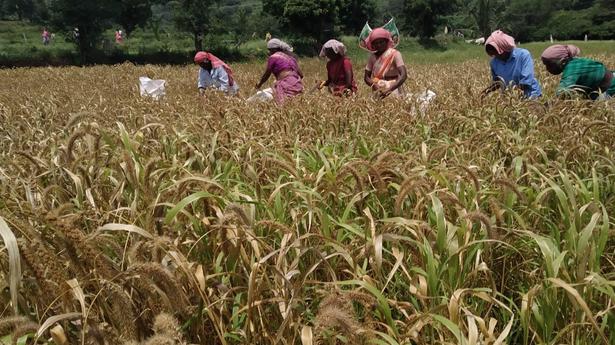
Odisha’s millet revival mission likely to benefit BJD
The Hindu
Intended at reviving millets in farms and on plates mostly in tribal areas, the ruling BJD is set to strengthen its base among tribals and women, riding on its success
The Naveen Patnaik Government last week approved the second phase of ‘Odisha Millet Mission (OMM)’ at an estimated investment of ₹2808.39 crore over six years, which is touted to be the second largest targeted agricultural programme after Krushak Assistance for Livelihood and Income Augmentation (KALIA).
As the OMM is intended at reviving millets in farms and on plates mostly in tribal areas, the ruling Biju Janata Dal is set to strengthen its base further among tribals and women riding on the success of the mission.
Just before 2019 elections (Lok Sabha and Assembly), the Naveen Patnaik-government had rolled out the ₹10,000-crore KALIA scheme which was aimed at relieving the debt-ridden farmers from the debt-trap by providing financial assistance to the vulnerable agriculture households, landless labourers as well as marginal cultivators of the State. As the cash was transferred to the accounts of farmers, the regional party was said to have reaped political benefits in the elections.
Now, Odisha has approved the second phase of OMM, which will be implemented between the financial year of 2021-22 and 2026-27. The focus of the mission will be the tribal region, where all three parties Bharatiya Janata Party, BJD and Congress are trying to become the preferred party for tribal voters.
A special Programme for Promotion of Millets in Tribal Areas of Odisha (Odisha Millets Mission) was launched by Odisha in 2017 to revive millets.
“It is the first of its kind of agriculture programme with priority on increasing consumptions in Odisha. The programme aims at a comprehensive revival of millets in farms and plates to promote climate-resilient farming and contribute to addressing micronutrient deficiency,” said the government.
Executed by women self-help groups and farmer producers organizations with the support of non-government organisations and research institutions under the aegis of Department of Agriculture and Farmers Empowerment, the OMM was first made operational in 30 blocks across seven districts such as Gajapati, Kalahandi, Kandhamal, Koraput, Malkangiri, Nuapada, and Rayagada. It was gradually expanded to 84 blocks in 15 districts.











